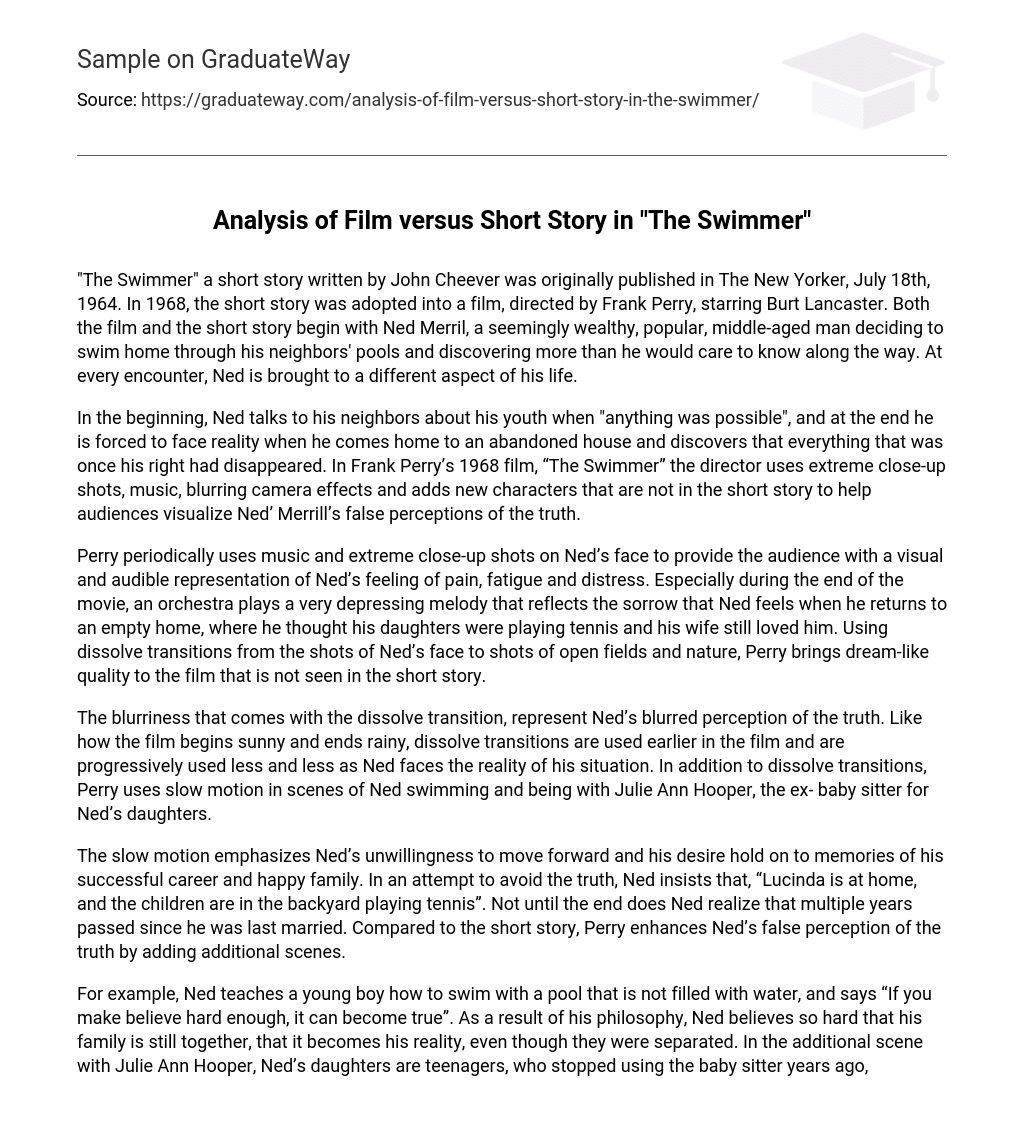“The Swimmer” a short story written by John Cheever was originally published in The New Yorker, July 18th, 1964. In 1968, the short story was adopted into a film, directed by Frank Perry, starring Burt Lancaster. Both the film and the short story begin with Ned Merril, a seemingly wealthy, popular, middle-aged man deciding to swim home through his neighbors’ pools and discovering more than he would care to know along the way. At every encounter, Ned is brought to a different aspect of his life.
In the beginning, Ned talks to his neighbors about his youth when “anything was possible”, and at the end he is forced to face reality when he comes home to an abandoned house and discovers that everything that was once his right had disappeared. In Frank Perry’s 1968 film, “The Swimmer” the director uses extreme close-up shots, music, blurring camera effects and adds new characters that are not in the short story to help audiences visualize Ned’ Merrill’s false perceptions of the truth.
Perry periodically uses music and extreme close-up shots on Ned’s face to provide the audience with a visual and audible representation of Ned’s feeling of pain, fatigue and distress. Especially during the end of the movie, an orchestra plays a very depressing melody that reflects the sorrow that Ned feels when he returns to an empty home, where he thought his daughters were playing tennis and his wife still loved him. Using dissolve transitions from the shots of Ned’s face to shots of open fields and nature, Perry brings dream-like quality to the film that is not seen in the short story.
The blurriness that comes with the dissolve transition, represent Ned’s blurred perception of the truth. Like how the film begins sunny and ends rainy, dissolve transitions are used earlier in the film and are progressively used less and less as Ned faces the reality of his situation. In addition to dissolve transitions, Perry uses slow motion in scenes of Ned swimming and being with Julie Ann Hooper, the ex- baby sitter for Ned’s daughters.
The slow motion emphasizes Ned’s unwillingness to move forward and his desire hold on to memories of his successful career and happy family. In an attempt to avoid the truth, Ned insists that, “Lucinda is at home, and the children are in the backyard playing tennis”. Not until the end does Ned realize that multiple years passed since he was last married. Compared to the short story, Perry enhances Ned’s false perception of the truth by adding additional scenes.
For example, Ned teaches a young boy how to swim with a pool that is not filled with water, and says “If you make believe hard enough, it can become true”. As a result of his philosophy, Ned believes so hard that his family is still together, that it becomes his reality, even though they were separated. In the additional scene with Julie Ann Hooper, Ned’s daughters are teenagers, who stopped using the baby sitter years ago, but Ned continues to wonders “why she doesn’t come over to babysit? In addition to his distorted sense of time, Ned also attempts to kiss Julie, even though he is still supposed to have a wife in his imagination. A similar event occurs between Ned and his former mistress, where he thinks that they still have an affair, but he had not contacted her for multiple years. In order to relieve himself of the pain of losing his wife, Ned attempts to escape his current situation by trying to start a relationship with other woman.
The combination of the additional scenes, depressing music, blurring camera effects, and close-up camera shots create an effect that cannot be read in the short story. While the short story uses imagination to visualize the characters and events person. The film uses concrete shots and images to more effectively convey the emotions of Ned Merrill, the grandiose of the neighbor’s homes and the slowed passage of time. Although Ned Merrill swims forward, he moves backwards in his life and discovers the truth about his family.





